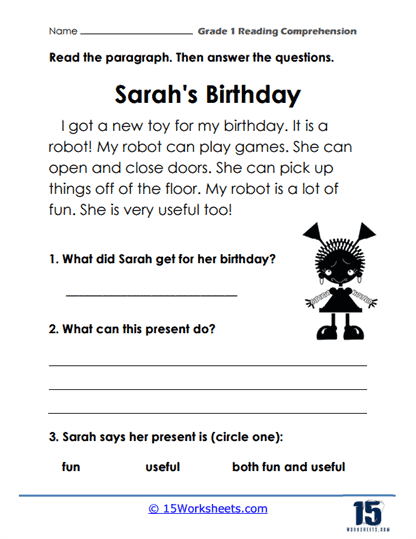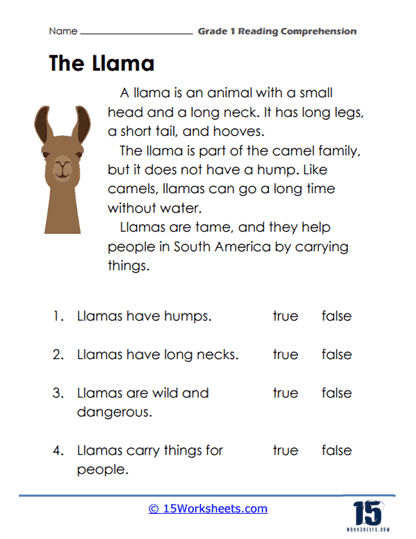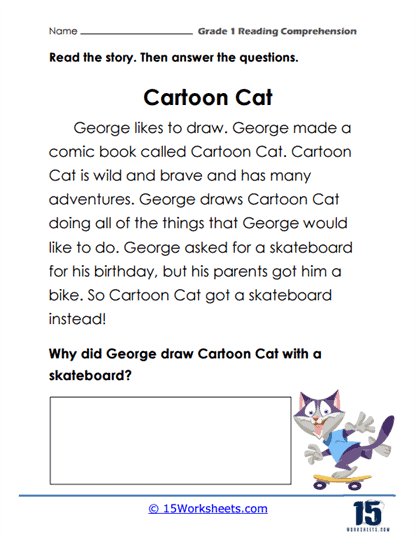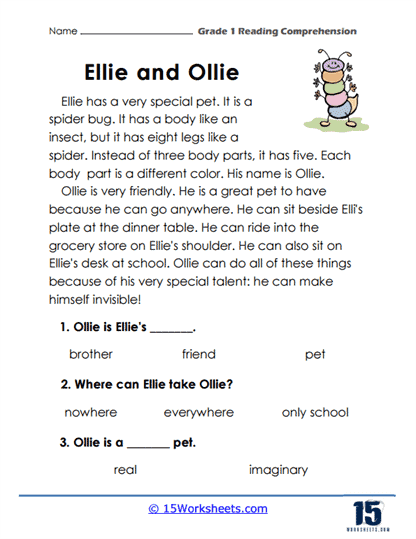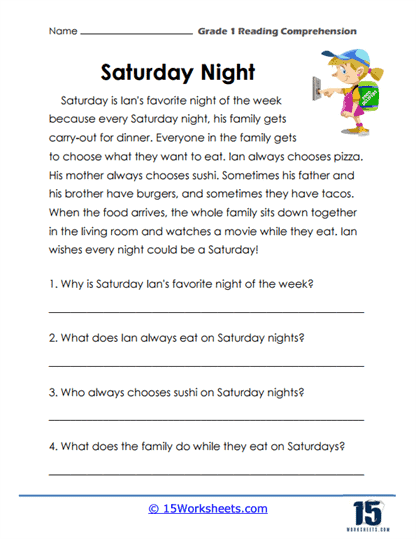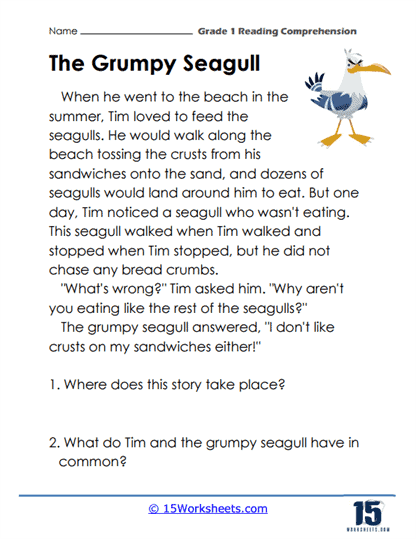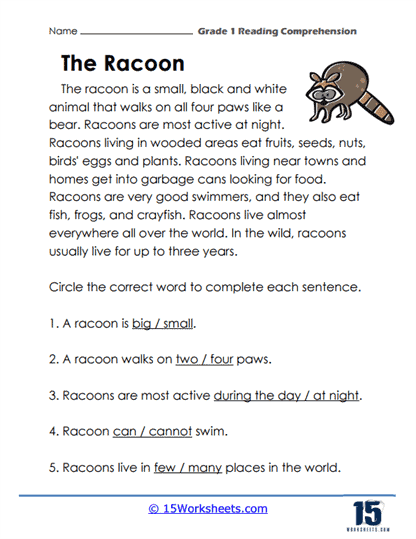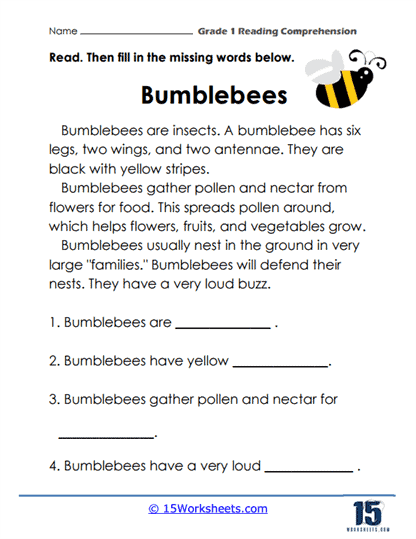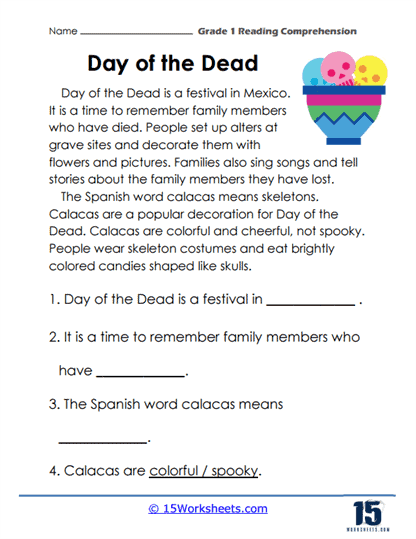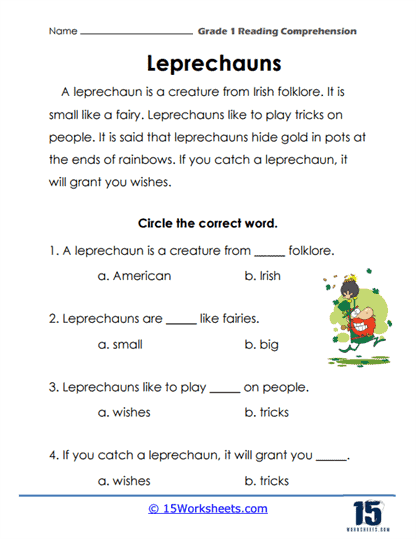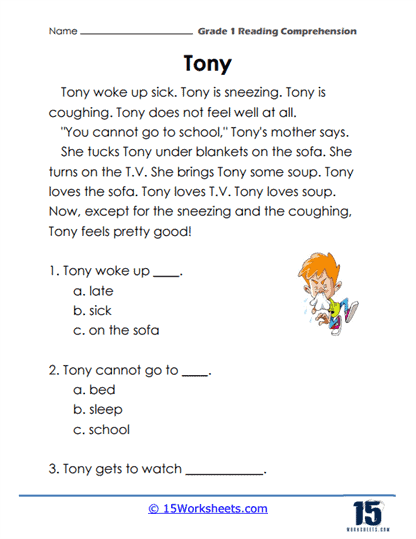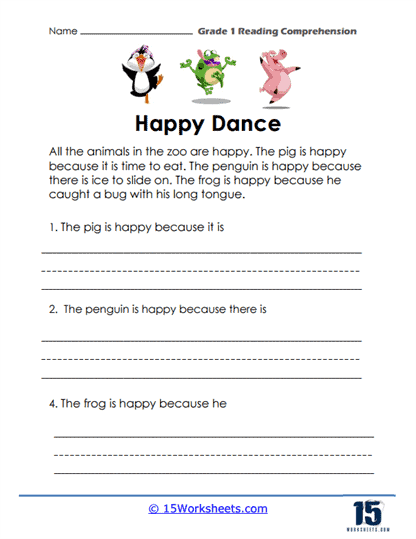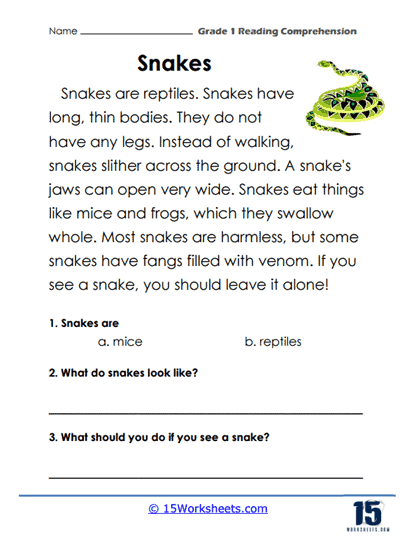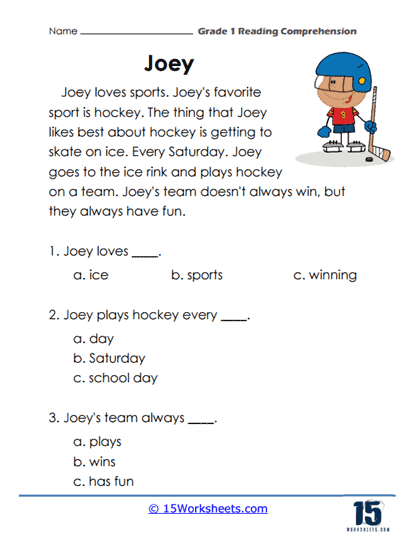Grade 1 Reading Comprehension Worksheets
All About These 15 Worksheets
Reading comprehension is one of the foundational skills every young learner needs to master in order to succeed not only academically but also in life. For first graders, this skill is especially critical as they transition from learning basic literacy elements to actively engaging with text to derive meaning. These worksheets are carefully crafted tools designed to help first graders enhance their reading comprehension abilities in a structured, engaging, and progressive manner. But what makes these worksheets so valuable, and how can they specifically support young students in developing their literacy skills?
Catering to the Developmental Stage of First Graders
First graders, typically aged 6 to 7, are at a stage where they are building a wide array of early reading skills. They have generally developed the ability to recognize and pronounce alphabet letters, both uppercase and lowercase, and are becoming familiar with basic phonics. These worksheets take into account the developmental needs of these young readers by presenting simple but engaging short passages, followed by questions that help reinforce their understanding. The worksheets bridge the gap between recognizing letters and words, and the more complex task of understanding and interpreting full sentences and paragraphs.
By providing short passages, these worksheets prevent young learners from becoming overwhelmed. A first grader is just beginning to tackle the challenge of reading longer texts. These worksheets allow them to engage with digestible content while practicing the vital skill of decoding meaning from context.
Recognize Main Ideas and Supporting Details
A key aspect of reading comprehension is being able to distinguish the main idea of a passage from its supporting details. For a first grader, this skill is not innate-it needs to be nurtured through practice and repetition. The comprehension worksheets do just that.
For example, a passage might describe a child’s morning routine. The worksheet would then ask students to identify the main activity, such as “What did the child do first in the morning?” The question reinforces the student’s ability to pinpoint the central message of the text. By summarizing the key ideas and noticing the smaller details that support the narrative, children develop a deeper understanding of how stories and informational texts are structured.
Making Inferences and Drawing Conclusions
While first graders may be learning to read basic words and phrases, they are also capable of thinking critically about what they read, even if they may not realize it. Comprehension worksheets encourage students to make inferences and draw conclusions based on clues from the text. For instance, a worksheet may present a story about a rainy day and then ask, “Why did the girl wear boots and carry an umbrella?” This encourages the student to use context clues (the description of the weather) to infer the reason behind the character’s actions.
In this way, the worksheets foster a level of engagement beyond simply reading the words on the page. Students learn to “read between the lines,” a skill that will serve them throughout their academic career. They begin to understand that stories and texts do not always state everything explicitly—sometimes, the reader has to make connections using their own logic and reasoning.
Expanding Vocabulary Through Context
For young readers, encountering unfamiliar words in context is an important way to build vocabulary. The Grade 1 Reading Comprehension Worksheets often introduce students to new words within the framework of simple stories or descriptions. These new words, when paired with supportive questions and guided reflection, enable students to expand their vocabulary in a meaningful way.
Imagine a passage about animals in the zoo. A word like “habitat” might be introduced. While the word may be unfamiliar at first, the worksheet will guide the student to infer its meaning based on how it’s used in the sentence, such as “The tiger lives in a large habitat with trees and a pond.” The follow-up questions might ask, “What is a habitat?” prompting the child to derive the definition from the context.
This method of learning new vocabulary words not only enhances the child’s lexicon but also boosts their confidence in reading new and more challenging texts.
Recognizing Literary Elements
Even at a young age, students can begin to grasp the basic building blocks of stories-characters, settings, plots, and themes. The worksheets designed for first graders are often structured in a way that allows children to identify these literary elements without overwhelming them.
For instance, after reading a short story about a dog going on an adventure, students might be asked, “Who is the main character?” (character identification) or “Where did the adventure take place?” (setting). These basic questions help students start to think critically about the structure of narratives and understand that all stories have these key elements.
These early lessons about literary elements prepare students for more complex literary analysis in later grades. The act of identifying and discussing these elements in simple, accessible stories builds a foundation for deeper discussions about character motivation, plot structure, and themes in future texts.
Practicing Test-Taking Strategies
Another significant benefit of these worksheets is that they often mimic the format of standardized tests. While first graders may not yet face rigorous standardized testing, exposure to similar formats can help them develop essential test-taking skills. The worksheets typically present a text followed by multiple-choice or short-answer questions, requiring students to carefully read both the passage and the questions before answering.
This format helps students practice critical test-taking strategies, such as time management and attention to detail. Additionally, by working through these worksheets regularly, students gain confidence in their ability to comprehend and respond to texts, making them better prepared for any future assessments they might encounter.
Phonemic Awareness
At the heart of learning to read is phonemic awareness, the ability to identify and manipulate individual sounds, or phonemes, in words. This skill is crucial because it allows children to understand that words are made up of smaller sound units, which can be blended together or broken apart. For instance, in the word “cat,” a child with strong phonemic awareness can hear and recognize the sounds /k/, /a/, and /t/. Without this understanding, students would struggle to decode words, as they would be unable to make the connection between letters and sounds.
Phonemic awareness lays the foundation for phonics instruction by helping students develop the skill of sound segmentation and blending. They learn that letters correspond to specific sounds and that by putting those sounds together in different ways, they can create and understand words. It is often seen as the first step in the reading journey, and activities like rhyming, clapping syllables, and identifying the first or last sounds in words are all aimed at strengthening this skill.
Cracking the Code of Written Language
Once students have developed phonemic awareness, they move on to phonics, the method by which they learn to recognize and decode the sounds that make up words. Phonics instruction starts with teaching the most basic sound-letter correspondences and gradually progresses to more complex patterns, such as digraphs (like “sh” and “ch”) and blends (like “bl” or “st”). For first graders, mastering phonics is essential because it provides them with the tools to sound out unfamiliar words.
By the end of first grade, students should be able to recognize many high-frequency sight words and apply their phonics knowledge to decode one-syllable words with regular spelling patterns. Phonics is not just about reading words, but understanding the relationship between the sounds we hear and the letters that represent them, allowing students to read unfamiliar text with confidence and accuracy.
Fluency
Once students have a good grasp of phonics, the next essential skill is fluency. Fluency refers to the ability to read text accurately, quickly, and with appropriate expression. A fluent reader does not need to stop frequently to decode words or hesitate between sentences. Instead, they read smoothly, which allows them to focus more on understanding the content of what they are reading rather than struggling with individual words.
Fluency is developed through practice and repeated exposure to text. By reading aloud, students learn to pace themselves, vary their tone of voice, and express the emotions or tone of the text. Fluency helps first graders transition from learning to read to reading to learn. As they become more fluent, they can better comprehend stories and informational text, which in turn enhances their enjoyment of reading.
Vocabulary
Vocabulary development is another cornerstone of reading success in first grade. A robust vocabulary allows students to understand what they are reading and to communicate their thoughts and ideas effectively. First graders build their vocabulary by encountering new words through direct instruction, conversations, and by listening to books read aloud. They also learn to deduce the meanings of new words using context clues, a skill that becomes increasingly important as they encounter more complex texts.
Vocabulary instruction in first grade often involves teaching students words that are relevant to their everyday experiences, but it also introduces them to more academic and content-specific language. For example, students may learn words related to science or math, which helps them grasp new concepts and participate in classroom discussions. The larger a student’s vocabulary, the easier it becomes to understand and enjoy reading, as they are not bogged down by unfamiliar terms.
Comprehension
The ultimate goal of learning to read is comprehension—the ability to understand and make meaning from the text. In first grade, students begin to develop comprehension skills by learning how to identify the main ideas in a story, as well as key details. They are also taught to make inferences and draw conclusions based on the text, which are higher-level thinking skills that will be developed further in later grades.
Comprehension is more than just recalling facts from a story; it also involves understanding character motivations, identifying themes, and recognizing literary elements like plot and setting. In first grade, students are encouraged to retell stories in their own words, which helps them internalize the content and demonstrate their understanding. Additionally, comprehension activities may include asking students to compare and contrast characters or to discuss the central message or moral of a story. These skills not only improve their ability to understand text but also enhance their critical thinking abilities.
Sight Word Recognition
Not all words can be easily decoded using phonics rules. Sight word recognition involves quickly identifying common words that do not follow regular phonetic patterns, such as “the,” “said,” or “was.” First graders spend a significant amount of time memorizing these sight words, which allows them to read more fluently without stopping to decode every word.
By mastering sight words, students can focus more on understanding the overall meaning of the text rather than getting stuck on tricky, irregular words. This skill not only boosts fluency but also builds confidence, as students are able to read more complex sentences with ease.

